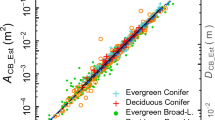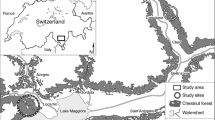Abstract
Key message
Using the pipe model theory, a quantitative relationship between leaves and non-green plant organs has been defined that depends on tree size.
Abstract
In the pipe model theory, the cumulative mass of leaves and the density of non-photosynthetic organs at depth (z) from the crown surface of a woody plant are defined as F(z) and C(z), respectively. In this study, the F(z)–C(z) relationship was approximated by a non-rectangular hyperbola for Abies veitchii, Chamaecyparis obtusa, Cryptomeria japonica and Larix leptolepis. The initial slope of the non-rectangular hyperbola, corresponding to the specific pipe length, varied among individual trees. The relationship between the initial slope and the square of the stem diameter at the crown base, which can be expressed as a power function with positive exponents, was species dependent. Based on the size dependence of the initial slope, the value of the allometric exponent describing the relationship between leaf mass and the square of the stem diameter at the crown base was theoretically shown to exceed unity. Empirically, the value of the allometric exponent usually exceeds two. However, in the allometric model developed here, the allometric exponent between the leaf mass and the square of the stem diameter at the crown base did not differ significantly from unity, indicating that the leaf mass was directly proportional to the stem cross-sectional area at the crown base.






Similar content being viewed by others
References
Berninger F, Nikinmaa E (1997) Implications of varying pipe model relationships on Scots pine growth in different climates. Funct Ecol 11:146–156
Berninger F, Coll L, Vanninen P, Mäkela A, Palmroth S, Nikinmaa E (2005) Effects of tree size and position on pipe model ratios in Scots pine. Can J For Res 35:1294–1304
Blackman FF (1905) Optima and limiting factors. Ann Bot 19:281–296
Chiba Y, Fujimori T, Kiyono Y (1988) Another interpretation of the profile diagram and its availability with consideration of the growth process of forest trees. J Jpn For Soc 70:245–254
Enquist BJ, Brown JH, West GB (1998) Allometric scaling of plant energetics and population density. Nature 395:163–165
Enquist BJ, Economo EP, Huxman TE, Allen AP, Ignace DD, Gillooly JF (2003) Scaling metabolism from organisms to ecosystems. Nature 423:639–642
Enquist BJ, Allen AP, Brown JH, Gillooly JF, Kerkhoff AJ, Niklas KJ, Price CA, West GB (2007) Biological scaling: does the exception prove rule? Nature 445:E9–E10
Hagihara A, Yokota T, Ogawa K (1993) Allometric relations in hinoki (Chamaecyparis obtusa (Sieb. et Zucc.) Endl.) trees. Bull Nagoya Univ For 12:11–29
Hozumi K (1981) Production structure and stand productivity in Larix leptolepis plantations. In: Asada S, Satoo T (eds) Silviculture of Larix. Norin-Shuppan, Tokyo, pp 89–106
Johnson IR, Thornley JHM (1984) A model of instantaneous and daily canopy photosynthesis. J Theor Biol 107:531–545
Kershaw JA, Maguire A (2000) Influence of vertical foliage structure on the distribution of stem cross-sectional area increment in western hemlock and balsam fir. For Sci 46:86–94
Kikuzawa K (1988) Intraspecific competition in a natural stand of Betula ermanii. Ann Bot 61:727–734
Mäkelä A (2002) Derivation of stem taper from the pipe theory in carbon balance framework. Tree Physiol 22:891–905
Mäkelä A, Albrektson A (1992) An analysis of the relationship between foliage biomass and crown surface area in Pinus sylvestris in Sweden. Scand J For Res 7:297–307
Mäkelä A, Valentine HT (2006) Crown ratio influences allometric scaling in trees. Ecology 87:2967–2972
Mäkelä A, Vanninen P (1998) Impacts of size and competition on tree form and distribution of aboveground biomass in Scots pine. Can J For Res 28:216–227
Mäkelä A, Virtanen K, Nikinmaa E (1995) The effects of ring width, stem position, and stand density on the relationship between foliage biomass and sapwood area in Scots pine (Pinus sylvestris). Can J For Res 25:970–977
McDowell N, Barnard H, Bond BJ, Hinckley T, Hubbard RM, Ishii H, Köstner B, Magnani F, Marshall JD, Meinzer FC, Phillips N, Ryan MG, Whitehead D (2002) The relationship between tree height and leaf area: sapwood area ratio. Oecologia 132:12–20
Mencuccini M, Grace J (1995) Climate influences the leaf area/sapwood area ratio in Scots pine. Tree Physiol 15:1–10
Miyaura T, Kurachi N, Hozumi K (1982) Biomass in a Larix leptolepis plantation. Trans. 30th Mtg. Chubu Bra. Jpn For Soc:11–12
Monsi M, Saeki T (1953) Über den Lichtfaktor in den Pflanzengesellschaften und seine Bedeutung für die Stoffproduction. Jpn J Bot 14:22–52
Ogawa K (2007) Self-thinning and stand dynamics of even-aged pure stands of sugi (Cryptomeria japonica) and hinoki cypress (Chamaecyparis obtusa). In: Scaggs AK (ed) New research on forest ecology. Nova Science Publishers, New York, pp 141–186
Ogawa K, Hagihara A (2003) Self-thinning and size variation in a sugi (Cryptomeria japonica D. Don) plantation. For Ecol Manage 174:415–423
Ogisu K (1985) Biomass and growth in a 15-year-old Cryptomeria japonica plantation. Bachelor thesis, Nagoya University, Nagoya, Japan, 100 p
Press WH, Teukolsky SA, Vetterling WT, Flannery BP (1992) Numerical recipes in C, 2nd edn. Cambridge University Press, Cambridge, p 994
Schneider R, Berninger F, Ung C-H, Mäkelä A, Swift DE, Zhang SY (2011) Within crown variation in the relationship between foliage biomass and sapwood area in jack pine. Tree Physiol 31:22–29
Shelburne VB, Hedden RL, Allen RM (1993) The effects of site, stand density and sapwood permeability on the relationship between leaf area and sapwood area in loblolly pine (Pinus taeda L.). For Ecol Manage 58:193–209
Shidei T (1965a) Productivity of forest ecosystems in terms of cycling of matter. Material 1:160–177
Shidei T (1965b) Productivity of forest ecosystems in terms of cycling of matter. Material 2:223–238
Shinozaki K, Yoda K, Hozumi K, Kira T (1964a) A quantitative analysis of plant form-the pipe model theory. I. Basic analysis. Jpn J Ecol 14:97–105
Shinozaki K, Yoda K, Hozumi K, Kira T (1964b) A quantitative analysis of plant form-the pipe model theory. II. Further evidence of the theory and its application in forest ecology. Jpn J Ecol 14:133–139
Sone K, Suzuki AA, Miyazawa S, Noguchi K, Terashima I (2009) Maintenance mechanisms of the pipe model relationship and Leonardo da Vinci’s rule in the branching architecture of Acer rufinerve trees. J Plant Res 122:41–52
Tanao T (1981) Biomass and growth in a Chamaecyparis obtusa plantation. Bachelor thesis, Nagoya University, Nagoya, Japan, 151 p
Thornley JHM (1976) Mathematical models in plant physiology. Academic Press, London, p 318
Warton DI, Wright IJ, Falster DS, Westoby M (2006) Bivariate line fitting methods for allometry. Biol Rev 81:259–291
Weiner J (1988) Variation in the performance of individuals in plant populations. In: Davy AJ, Hutchings MJ, Watkinson AR (eds) Plant population ecology. Blackwell, Oxford, pp 59–81
Weiner J (1990) Asymmetric competition in plant populations. Trends Ecol Evol 5:360–364
Weiner J, Thomas SC (1986) Size variability and competition in plant monocultures. Oikos 47:211–222
Weiner J, Whigham DF (1988) Size variability and self-thinning in wild-rice (Zizania aquatica). Am J Bot 75:445–448
West GB, Brown JH, Enquist BJ (1997) A general model for the origin of allometric scaling laws in biology. Science 276:122–126
West GB, Brown JH, Enquist BJ (1999) The fourth dimension of life; fractal geometry and allometric scaling of organisms. Science 284:1677–1679
Xue L, Hagihara A (1999) Density effect, self-thinning and size distribution in Pinus densiflora Sieb. et Zucc. stands. Ecol Res 14:49–58
Yamakura T, Hagihara A, Sukardjo S, Ogawa H (1987) Tree form in a mixed Dipterocarp forest in Indonesian Borneo. Ecol Res 2:215–227
Author contribution statement
The author (KO) designed research, collected the data, analyzed them, and wrote the paper.
Acknowledgments
I thank David Warton and Daniel Falster for their helpful advice on the use of the freely available software program SMATR.
Conflict of interest
The author (KO) declares that he has no conflict of interest.
Author information
Authors and Affiliations
Corresponding author
Additional information
Communicated by E. Priesack.
Rights and permissions
About this article
Cite this article
Ogawa, K. Mathematical consideration of the pipe model theory in woody plant species. Trees 29, 695–704 (2015). https://doi.org/10.1007/s00468-014-1147-2
Received:
Revised:
Accepted:
Published:
Issue Date:
DOI: https://doi.org/10.1007/s00468-014-1147-2




